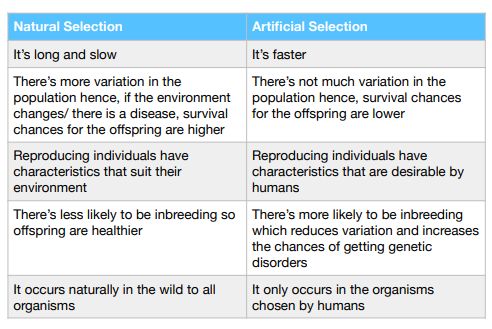Variation - Selective Breeding (GCSE Biology)
New 2 Selective Breeding
Using Selective Breeding
Use of Selective Breeding
Selective breeding involves choosing plants and animals with the best traits (e.g. most food producing) and breeding them more. It is also known as artificial selection as you artificially select the organisms that will breed to increase the frequency of the desired characteristic in the population.
In this way, we are breeding for particular genetic characteristics. These characteristics can help the organism in many ways. For example, we can breed plants which are resistant to cold weather to improve production by crops in the winter.
Humans have been doing this for thousands of year. Farmers often find wild crops or wild animals with good traits, and then breed them to produce lots of their own plants and animals with the desired characteristics.
Artificial vs. Natural Selection

Selective Breeding in Plants
All sorts of crops are selectively bred. This includes corn, peaches and bananas.
They are bred selectively for many beneficial characteristics, including:
- Large fruits
- Resistance against disease
- Increased crop yield
- Greater aesthetic beauty, such as larger flowers or more unusual flowers
Selective Breeding in Animals
Animals are bred selectively to increase the changes of certain characteristics. These include:
- Increased meat yield
- Increased milk yield
- Large eggs from chickens
- Desirable characteristics in domestic dogs, such as a gentle nature
Mechanism of Selective Breeding
Step by Step Process
You need to understand the step-by-step mechanism in selective breeding:
- Choose parents with the desired characteristics. If you are trying to breed cows with a high yield of milk, choose a cow that has a high milk yield and a bull, who’s mother had a high milk yield. They must be from a mixed population.
- Breed them together. Breed the selected parents together. They will both have the desired genes and hence the offspring will also gain the desired genes.
- Breed the offspring with the desired characteristics. Not all of the offspring will have the characteristics that are selected for, therefore you only chose the desired offspring. Then breed these together.
- Continue this process over generations. Like natural selection, selective breeding occurs over many generations. The process is repeated again and again, and different factors can be selected for.
Example of Selective Breeding: Harry the Farmer
For example, Harry the Farmer has a crop of plants. His crop produce keeps suffering because of pests, which eat and ruin his crops. Out of his 5 crop fields, only the crops in field 4 survived the pests.

Therefore Harry picks out crops from field 4, and breeds these together. The offspring will have the genes to help them survive the pest attack.

The next generation of crops will have more resistant crops because they will have the genes from the crops in Field 4 of Generation A.

Positives and Negatives of Selective Breeding
Positives of Selective Breeding
There are several benefits for selective breeding both for the farmer or the consumer:
- Economical benefit – if a farmer can grow the crops with the largest fruits and the animals with the greatest yield of meat, they will get the most money. This aids the economy as their products will be of a greater quality and thus the consumer will also be happier.
- Domesticating animals – you can select for more docile household pets or animals that are safer to farm with.
- Prevent disease – you can prevent spread of disease amongst crops by using selective breeding to develop crops resistant to disease spread by pests.
Negatives of Selective Breeding
However, selective breeding can carry several dangers. The negatives are often related to inbreeding. If you breed lots of organisms of the same family, there can be a build up of recessive alleles, which increases the risk of disease:
- Selecting for rare diseases – some of the more selected for organisms have unexpected disadvantages. Through selective breeding, these disadvantages may accidentally be selected for. This is dangerous. Examples include how breeding Boxers has lead to breathing difficulties for the animals.
- Reduced genetic variation – by selecting for specific alleles, the genetic variation in a population decreases. This can reduce defences of the animals and plants against disease and insect attacks. This can be catastrophic for the species selected for.
- Ethical Issues – if organisms are purposefully bred with negative, harmful characteristics for research or other reasons, it raises ethical issues. For example, some dogs that are inbred have certain defects causing them problems.
Variation refers to differences in traits and characteristics among individuals within a species. This can occur naturally or as a result of selective breeding.
Selective breeding is the process of choosing certain individuals with desirable traits and characteristics to breed together in order to produce offspring with those traits.
Selective breeding is used to improve or enhance specific traits or characteristics in a population of organisms. This is commonly done in agriculture to produce crops or livestock with desirable traits such as increased yield or disease resistance.
Hybridization is the process of cross-breeding different species or varieties to produce a hybrid with desirable traits. This is often done in agriculture to produce crops with improved traits such as increased yield or disease resistance.
Hybrid vigor and heterosis refer to the improved traits and increased growth and survival rate of a hybrid compared to its parent species. This is a result of the mixing of genes from different species.
Inbreeding is the process of breeding individuals that are closely related, such as siblings or cousins. This can lead to a loss of genetic diversity and the expression of recessive traits or diseases.
Outbreeding is the process of breeding individuals that are not closely related, resulting in offspring with a greater genetic diversity. This can lead to improved traits and reduced expression of diseases.
Purebred animals are animals that are bred within a single breed or strain, while crossbred animals are animals that are produced from a cross between two different breeds or strains. Crossbred animals often have improved traits and increased genetic diversity compared to purebred animals.
Genetic engineering is the process of manipulating or altering the genetic material of an organism to produce desired traits or characteristics. This is often done in agriculture to produce crops or livestock with improved traits.
Gene editing is a type of genetic engineering that involves making specific changes to the genetic material of an organism. This can be used to correct genetic disorders or produce desired traits or characteristics in an organism.






Still got a question? Leave a comment
Leave a comment